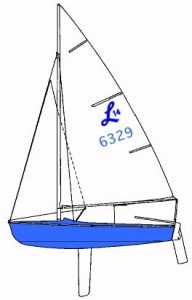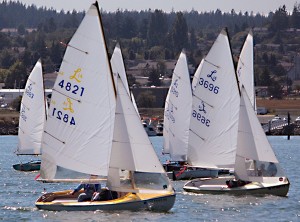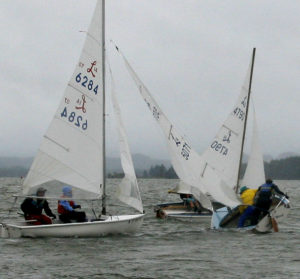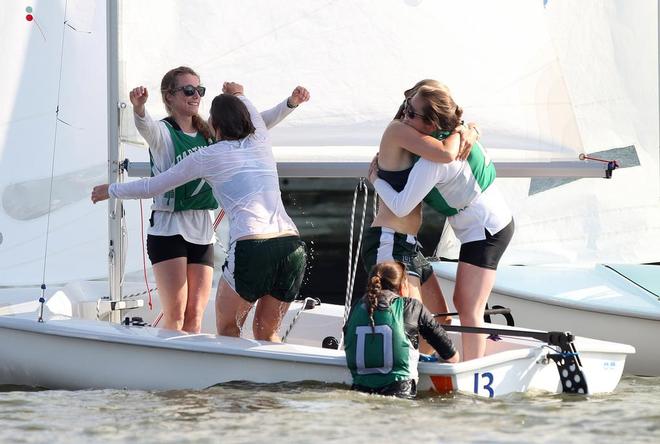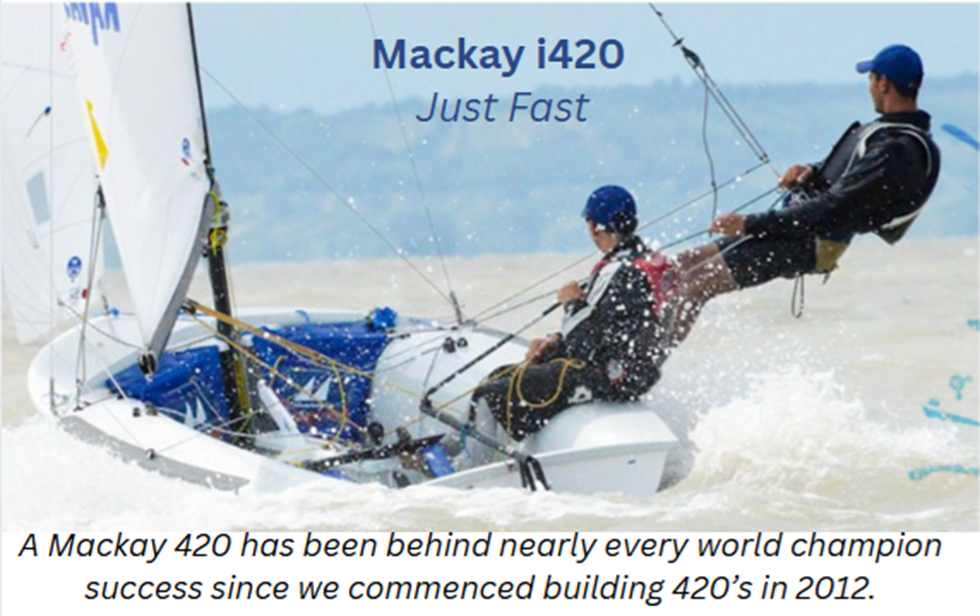Brad Boston (Sarnia, Ont.), sailing with Curtis Florence (Cleveland, OH) and Chad Corning (New Rochelle, NY) sat in third place after 11 races over three days of sailing from Alamitos Bay Yacht Club. That trio executed a classic come-from-behind finish on the fourth and final day to claim the 2014 Viper 640 North American Championship. Boston presided over a sailmakers’ boat handling seminar Friday night and was overheard commenting how it was unusual for him to be only four points off the lead without having won any of the 11 races sailed over the first three days. That quickly changed as the fleet of 35 Viper 640s headed out through the breakwater for the final day of racing.
ABYC PRO Steve Kuritz wrapped-up his successful regatta with the following overview: “In the end, it was four great days of racing, and it was really interesting to see how the positions of the top six boats changed from race to race. In the end, Brad Boston “thanked” me for calling him OCS on the day’s first start as it allowed him to quickly restart at the favored boat end and take off to the right side and win his first race.”
Boston’s middle crew, Chad Corning, commented that “It was good going into today with only four points separating the top three boats. We were able to play the favored right side all day and it paid off (line scores 1-1-3). In the end, Brad showed how he can be cool under pressure, keeping the mood on the boat light, and we made our moves to put us into the lead after today’s first race. From there, as the wind continued to build, we just tried to sail in the same neighborhood as Kevin Taugher and Jeff Grange.”
After the third day, Taugher and Boston were tied at 30 points just four points behind Grange who had lead in the scoring from the very first race. In the end, however, it was Taugher who finished second and Grange in third.
This year’s win is Boston’s fourth North American Championship (’09, ’10, ’11) and Corning was the middle crew for Jason Carroll’s NA victory last year in Houston.
The members and staff of the Alamitos Bay Yacht Club put on a spectacular four days of racing and shore-side hospitality. Tim Carter, ABYC Event Chairman, said “I’m glad it’s over…from an event task perspective; but I’m sorry to see all these great competitors leaving ABYC for their home ports across the country and across oceans, too.” All the competitors expressed their gratitude and appreciation for “Timbo’s” as, without all his efforts, the Championship would not have been such a glowing success.
Results of the Championship can be found at: http://www.abyc.org/upload/2014_Viper_NA3.htm. Photos from Bronny Daniels and Peter Howson are available to view at www.joysailing.com and www.yachtracing.us, respectively.
Next year’s Viper 640 North American Championship will be hosted by Larchmont (NY) Yacht Club in October 2015. Final results can be found on the ABYC website.
The Viper 640 North American Championship is a qualifier regatta for the EFG Viper Pan-American Championship. Also helping make this regatta a success are Ullman Sails, Doyle Sailmakers, North Sails, Quantum Sails, Goslings Rum, the Belmont Brewing Company, Rondar Sailboats USA, Sailing Pro Shop, and Rooster.
Final Results: http://www.abyc.org/upload/2014_Viper_NA7.htm
Blog
Lido 14: A Class of its Own
By Airwaves writer Tyler Colvin
Hand building boats is an art overlooked by many. Many of today’s sailing dinghies were originally hand crafted in garages, barns and basements before they hit high volume assembly lines. The Lido 14 is no exception. Originally built by legendary boat builder Bill Schock, the Lido 14 came to life out of his Newport Beach shop in early 1958. A year later, over 600 hulls had been cast and the one design class, as we know it today, started. There are currently over 6000 hulls with more on the way.
The Boat: A Local Legend
There are many boats who’s popularity is solely location based. How many Cape Cod Mercuries do you suppose are sailing around Penobscot Bay? Likewise, the intensely Southern California concentration of Lido 14s is most likely due to the locality of the designer and boat yard, Newport Beach.
The Lido 14 stands a stately 14’ long with a 6’ beam at the widest point. Dry hull weight is 310lbs, making it downright portly compared to the C420 or CFJ. Not designed as a racing boat, the Lido 14 gained popularity amongst racers in California, Oregon and Washington State as well as several other smaller groups spread across the country. It has a total sail area of 111 square feet between main and jib.
Designed for cruising, the Lido 14 comfortably sits 6 on its wide bench seats in a roomy cockpit. Races are a two person affair however, similar to many other small sailing dinghies of its size and vintage. Beamy and very difficult to capsize, it cruises comfortably and is very easy to set up.
In 1995 the Lido 14 was updated to reflect the progress in technology and update the pre-1960s hardware. These new Lidos, referred to as the 6000 series boats (as to that date, approximately 6000 hulls had been cast), were designed to be as similar as possible to the now “Classic Lido” with only updates to the construction and hardware on the boat. Because of the effort to keep the boats as similar as possible, both Classic and 6000 series boats are still very competitive on the racecourse. In fact, one of the first of the Classic Lido hulls won Lido 14 Nationals in 2014 (hull #2506, Cal State Long Beach Sailing Team standout Mark Ryan and crew Sarah Shaupeter).
Set Up and Sailing
The set up is straightforward and intentionally easy on the Lido 14. Designed to span many age groups and abilities, it comes together quickly and can either be disassembled after use or stored on a dock, mooring, or cradle. The deck-stepped mast is easily erected and stayed into place by two or more people. On Classic Lidos, the boom slides into a track on the mast and should be fixed in place by either a stopper inside the mast track, or a pin through the front of the mast. 6000 series boats have a fixed gooseneck that is fairly straightforward.
Tuning the Lido is also not complicated. Mast rake is the most easily adjusted mechanism and controls the power and helm of the boat. A reliable tuning guide from Ullman Sails can be found here (http://www.lido14.org/). Once your rig is set to the proper settings, the boat can be launched, sails raised and centerboard lowered.
Sailing upwind the Lido 14 has what is known as “weather helm”. Weather helm refers to the phenomenon where when sailing in a straight line on close-hauled, the tiller will tend to want to pull down and boat to head up. This is completely normal for many boats including the J24. As breeze increases however, this weather helm may become too strong and the boat should be depowered to decrease this pull.
Downwind the Lido 14 is sailed wing on wing when breeze allows. In racing conditions the centerboard can be raised slightly to help reduce drag on the hull. The jib is put on a whisker pole to allow it to fly out and catch more wind like a spinnaker would in the same situation. It is fast to heel the boat to windward slightly in order to rotate the main up higher and power up more.
Class Association
The Lido 14 class association (http://www.lido14.com) is an organized and helpful organization for such a relatively small racing community. Class championships are popular and provide a mix of Classic and 6000 series boats, as well as sailors young and old. The current Lido 14 National Champions, Mark Ryan and Sarah Shaupeter are perfect examples of a Classic boat with a young crew. Mark and Sarah sailed the oldest boat in the fleet #2506, previously owned by their grandfather. A recent graduate and Cal State Long Beach Sailing Team standout, Mark has a passion for Lidos and it is great to see a young skipper taking such interest in an older boat.
Why Sail?
Young, old, new or veteran, the Lido 14 has possessed the ability to maintain its status as one of the classic small dinghies in the United States. Competitive fleets on the West Coast keep racing alive; while countless others are cruised on lakes, rivers and ponds across the Midwest. Easily set up and easily sailed, the Lido 14 offers accessible sailing to many ability levels and age groups all over the country.
Viper 640 North Americans Day 1 Report
Jeff Grange Takes Control of Viper 640 North Americans After First Day
September 3, 2014 Long Beach, CA – Some championship regattas fall into the trope of “it’s never like this here.” In Long Beach, California, this was not true thankfully for the Viper 640 fleet. Despite dire forecasts, several days of light winds during practice, and an hour on-shore postponement, the Viper 640 North American Championship enjoyed Chamber of Commerce conditions with a classic Long Beach seabreeze for the 34 boats in attendance. Sailing the inside course, the fleet sailed briskly through the relatively flat seas where hard hiking proved key for the day.
In the first race, the fleet split evenly going upwind with both sides of the fleet converging at the first mark. Blasting downwind the boats were hitting speeds in the low teens as boathandling proved a critical asset. In the end, Jeff Grange (Santa Barbara, CA) was first across the line. That statistic would repeat itself. Grange would go on to win all four races on the day, returning to shore with an eight-point lead over 3-time North American champion Brad Boston (Sarnia, ON), who holds a slim, one-point lead over local Kevin Taugher. “Everything was perfect here today,” said Boston. “The yellow boat just sailed better through the water than us today.”
ABYC PRO Steve Kuritz commented “The caliber of the racing among the Viper 640s today was as competitive as any racing I’ve ever been part of. The boats are so quick and responsive that watching the competitors race these sport boats was a thrill. We’re expecting the next three days to provide the same ideal racing conditions.”
Event Chairman, Tim Carter, was on the water racing his Viper after having organized a world-class regatta. The previous night, after the Viper 640’s Annual General Meeting, Carter arranged for gourmet food trucks to feed and entertain the sailors. “It was a load of fun with everyone milling around the food trucks and eating on the decks of the boats on their trailers.” At the AGM, the class elected new officers, with local sailor Jim Sears assuming the role of Class President.
This is the first Viper North Americans sailed on the west coast. Thursday’s racing is scheduled to be in the ocean outside the Long Beach breakwater, with the first warning at 1155 with a sea breeze forecast to be from the southwest in the 12-15 knot range, building throughout the day.
The Viper 640 North American Championship is a qualifier regatta for the EFG Viper Pan-American Championship. Also helping make this regatta a success are Ullman Sails, Doyle Sailmakers, North Sails, Quantum Sails, Goslings Rum, the Belmont Brewing Company, Rondar Sailboats USA, Sailing Pro Shop, and Rooster. Event website: http://www.regattanetwork.com/event/6130
Lessons From the Sting of Defeat: The 34th America’s Cup from the Kiwi Perspective
Editors Note: Ahh, sailboat racing. No matter how talented, prepared, and invested you are into any particular boat or regatta, this sport, it seems more than most, can offer up bitter and cruel defeats. I personally have had my share of those, losing a major regatta by 1/4 of a point (back when 1st place was 3/4 of a point!), winning 3 of 4 races in a 70-boat J/24 regatta, then learning one was a dreaded OCS, and more. It can be hard to take, and much credit should go to those that keep at it, letting bad things go, and savoring the great moments. Someone once said “I never lose, I either win or get better.” This attitude, or some similar form of it, is what drives the best to the pinnacle. For example, Mike Holt has been at 505 sailing now for 30 years, and just won his first World Championship.
I must be getting old, but the old ABC Sports television intro comes to mind:
At what some see as the pinnacle of our sport, the sailing world watched one of the greatest, or one of the worst, dramas unfold in San Francisco at the 34th America’s Cup. The most improbable of all comebacks, or thrilling victories, and also one of the the most agonizing of all defeats, played out on the waters of SF Bay, narrated by American commentators, triumphal at the end, and Kiwi analysts, shocked at the crushing defeat. Our New Zealand correspondent, Sara Morgan Watters, got a chance to catch up with Peter Montgomery, the voice of NZL Yachting, and get his thoughts on what happened, and why.
By Airwaves Kiwi Correspondent, Sara Morgan Watters
Race 8 is what Peter Montgomery, New Zealand’s voice of yachting, will most remember of the 34th America’s Cup. Known by most as PJ, avid sports fans remember him best for his iconic call in 1995 “America’s Cup is now New Zealand’s Cup!” But broadcasting in 2013, those words, for a brief moment were only sweet memories for fans watching, during what became one of sport’s greatest comebacks.
Although PJ wasn’t able to repeat those famous words during his coverage in San Francisco, he did get an insiders view of the Cup that he recently shared at an evening presentation I attended at the Royal Port Nicholson Yacht Club in Wellington. In an attempt to better understand how Emirates Team New Zealand lost their lead to go on to lose the Cup, PJ broke it down into three main mistakes, holding ETNZ players both on and off the water responsible.
1. Kiwis made a mistake on the water
According to PJ, the beginning of the end was in Race 8 when Team New Zealand nearly capsized, after a last minute decision to tack because of a questionable port/starboard crossing. Problems with the hydraulics during the tack caused the one hull to lift out of the water, making the boat heel to a 44.8 degree angle. Only .2 degrees away from capsizing, at the time it was a victory that the team managed to recover with out any damage, but according to PJ, this was the first of three costly mistakes that lead to their defeat.
Eager to gain some insider knowledge and a better understanding of how this important crossing unfolded, PJ re-played this painful moment to the audience. I could feel the tension in the room rise as the footage revealed that in fact the Kiwis would have crossed on port cleanly with on-board audio between Oracle’s Ben Ainslie and skipper Jimmy Spithill confirming this as they discussed having to sail behind the Kiwi team. Instead, in a moment of hesitation, the Kiwis decided to tack, causing a near disaster. The icing on the cake was the American announcers, Gary Jobson and Ken Read (broadcasters that didn’t appear on Kiwi coverage) saying “airplane tickets are being changed from Monday to Tuesday”, as Team Oracle took the lead to go on and win the race and prolong the series.
2. The Kiwis made a mistake off the water
According to PJ, the second mistake came on Friday 13th, when Team New Zealand officially decided they didn’t need to use the reserve day and that the team would be better off resting. This extra day gave Oracle time to go out on the water and practice, exactly what they needed, according to PJ. In addition to Team New Zealand giving up their momentum, Oracle was able to work on their speed, angles sailing upwind, and foiling through jibes and tacks. This extra practice gave Oracle the speed they needed to be more competitive.
PJ wasn’t shy to attribute the decision to take the lay-day to rest as a political error in judgment. Waving paper up in the air in front of the audience, PJ explained that they were copies of the email from Grant Dalton explaining to race organizers the team’s decision to take the day off the water, when in fact it was really only the team owner’s choice.
3. Kiwis didn’t play the mental game
Although PJ never suggested anyone cheated, his third point was that the Kiwis missed the opportunity to pursue clarification with the rules on how the hydraulic system should work. From his point of view, it was clear the hydraulic system that controlled the foils was simplified on the Team USA boat, making it easier to use.
Having watched sailors prepare for major events like the Olympics and other high stress world championships, PJ recognized the importance of understanding and playing the mental game of sailing and he felt there was a missed opportunity to play the game. The mistake being that, the Kiwis should have addressed this issue earlier, so to distract Oracle away from the racing.
The theme of the evening presentation certainly wasn’t how Team USA won the America’s Cup, but rather how Team New Zealand lost it. The speech directed neither negativity nor cause for defeat towards Team USA, but instead focused on the mistakes the Kiwis made that eventually led to their loss.
When asked his thoughts on the event, Wellington Ocean Sports Project Manager, organizer of the evening’s event, and local Kiwi, Matt Wood gave his own perspective on the matter…
“Although in the end Oracle clearly was the fastest boat in the 34th Americas Cup, it will go down as New Zealand’s biggest missed opportunity to win. After initial dominance there was a period of several days where the Cup was within our grasp, but lost due to some basic errors. Given everything Team New Zealand had in its favour heading into the regatta against Oracle (a jump on foiling and a significant speed advantage) it begs the question, can this team in its current configuration actually win? We can only hope this result has strengthened the teams resolve to solve the Americas Cup equation.”
As the speech was coming to a finish, the audience longing for those iconic words declared 18 years ago only to be cast as hallow echoes in 2013, PJ gave them the bitter sweet satisfaction of ending the night by reenacting those famous words one last time. And so the audience was left that evening with the memory of what could have been met alongside with slight optimism for what the future could hold.
2014 505 World Championships Report & Results
Six teams Vie for Title on final Day of Racing By Airwaves writer Katelyn Montero
All photos courtesy of: SAP 505 Worlds 2014/ Christophe Favreau
Kiel, Germany- The SAP 505 World Championship had 173 entries competing in Kiel, Germany this past week, making it the third largest world championship for the class in the past 60 years of racing. The regatta concluded on August 22 when two-time runner up Mike Holt finally completed his nearly 30 year quest to conquer a World Championship. The high number of entrants did not disappoint, as the racing was some of the most competitive that the class has ever seen. This regatta was also a prime example of just how popular the 505 class is in international competition, with competitors from 16 different countries gathering in Kiel to compete in the trapeze dinghies.
“I don’t think we’ve ever had anything like this,” said Holt before the final day of racing. “Six teams gunning for the title says how competitive it has been this year.” Holt and his crew Rob Woelfel were one of those six hopefuls, and after a fierce day of sailing they were finally able to snatch the coveted title of 505 World Champions.
Going into the final day of racing, Holt and Woelfel had only a marginal lead of two points over the Great Britain pair of Andy Smith and Tim Needham. It was early starts out of the gate that allowed Holt and Woelfel to hang on to their first place lead throughout the final competition. Smith and Needham fell to a final place finish of fourth, with the Australian duo Peter Nichols and Luke Payne taking second and German pair Dr. Wolfgang Hunger and Julien Kleiner eclipsing them for third.
Just now in their mid-20s, the Aussies were very pleased with their second place finish. Payne says that going into the regatta, their personal goal was for a top 10 finish. As the runner-ups, Payne and Nichols are setting their future sights on a world title.
The podium was nothing new to third-place finisher Hunger, who has accumulated a total of five World Champion titles in the 505 class. He and Kleiner were able to utilize their legendary speed sailing downwind to make it into the top three.
Rounding out the top five teams was another German duo, skipper Stefan Böhm and crew Gerald Roos.
The 505 World Championships was not just about cutting down race times, but also integrating cutting edge technology into the sport of sailing. Sponsor title SAP provided the race committee with a state of the art app as well as broadcasting live streaming of race updates so that families, friends and fans around the world could stay up-to-date on what was happening out on the course.
The technology used in the 505 World Championships is among other apps and mobile tracking integration that sailing regattas are beginning to test out and introduce. A longstanding challenge of the sport is how to bring the action onto the shore, and now with updates and breakthroughs in technology, the world of sailing is becoming more accessible than ever.
http://sap505worlds.com/
A Life in One Day: What's it's Like to be a College Sailing Coach
By Airwaves writer John Storck
Late August has always been a time of the year that I really enjoyed. Summer seems to ease off the throttle a bit. The temperature ceases to have me sweating in the shade. And everyone just tries to relax and enjoy what is left of another summer gone by. Of course it has also always meant “back to school” is right around the corner. Having recently retired from the ranks of college sailing coaching, at 31- I am not going “back to school” for the first time in my life. However, many of my peers are, and I want to wish them well.
The life of a college sailing coach was once described wisely as a “binge-work lifestyle.” It’s easy to look at the flexibility that a college coach has during the summer and be envious, but you may reconsider when you see them on the road for the entire weekend, for the seventh straight weekend of the fall. Yes, like any job it has it’s pros and cons. For those in the game, they know what’s around the corner. But for the rest of you, here’s a sampling of just some of the things that these coaches are going to work through in the next three months.
Roster Challenges
Uhoh… we have more skippers than crews this year. How are we going to keep all these people happy? Seriously, think about it…
Injuries
The truth is, college sailing is a lot different than it was 20 years ago. One of the biggest changes is how good everyone is at boathandling. That said, the manner in which the boathandling is performed these days can be taxing on the body. At some point, every coach will have to deal with a top player not being able to sail due to an injury. How to fill that player’s role (temporarily) without disturbing good vibes within the team is a huge challenge.
Sickness
Eventually, every coach will have to deal with this as well. The challenge of filling that player’s role is the same as the injury problem. However, what if he/she gets more of the team sick? Things can get ugly quick!
They’re College Kids, After All
Did you ever make a mistake in college? Well, chances are good that if you made the same mistake today, the consequences would be far greater. I’m not making any statements about whether that’s right or wrong, but it is reality. Every team will have at least one person deal with a disciplinary issue this season. Every coach just hopes it isn’t the whole team.
Travel Logistics
When you stay in as many hotel rooms and rent as many cars as a college sailing team does during a season, the odds of nothing going wrong become worse and worse. Over time, every college coach leans to just take these things in stride “Oh, they’ve never heard of us at the hotel you guys are trying to check into, even though I’m looking at the reservation in my email right now?…awesome!”
Facilities and Boats
At some point, a toilet is going to explode. Or maybe there will be a rodent infestation. Another great part of owning a large fleet of boats that are all the same vintage is that if one thing fails due to “normal wear and tear”: get ready because every boat is about to have the same problem. You just hope that these things don’t happen right before your big home event.
Team Drama
Probably the worst part of the job, but a certain inevitability. Everything might be going great for weeks, and then something happens within the squad that is totally out of your control, and now three people can’t stand to be within 30 feet of each other, and most likely two of them had been sailing together. Now what?
Individual Challenges
Now this is probably the most rewarding part of the job, but it can be incredibly painful to work through as well. When you have anywhere from 24 to 48 kids on a team, chances are more than good that you’re going to have some individuals who need to work on some non-sailing related things. Meeting expectations, working as a good teammate, becoming a leader, don’t come naturally to everyone. And for some, there are real growing pains through the process and it can be taxing on the coaching staff.
Now all that said, when the dust settles on top of the leaves in late November, nearly every coach will have something truly rewarding to look back on. Perhaps its a championship. Perhaps its a few big victories along the way. But more than likely, it’s some less tangible things. Maybe one of those individuals that has been tough made some real strides this season. Maybe one of your players had to deal with something tragic, and you and your team carried them through it. Whatever the case, there can be sources of tremendous pride at the end of each long, hard season.
So to all of my former colleagues, I wish you well heading back to campus. I hope your list of challenges is on the shorter side this season, and that they don’t hit at the worst possible time. But mostly, I hope you can sit down with your families at Thanksgiving and be proud of the accomplishments behind you, both on and off the water.
Good luck, old friends.
Sail1Design invites you to share your memorable coaching experience(s) below!

